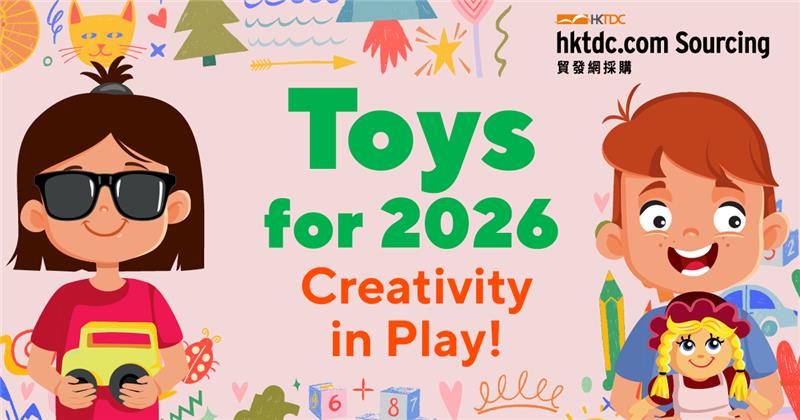The toy and game industry is a dynamic market, constantly evolving to meet the demands of tech-savvy kids and parents who prioritize education, sustainability, and engaging play experiences. As we look ahead to 2026, several key trends are emerging that global buyers and suppliers need to understand to stay ahead of the curve.
Toys & Games Market Overview
The global toys and games market is projected to reach over US$169.98 billion by 2033, supported by a steady compound annual growth rate (CAGR) of 4.8% starting from 2026 according to a study by Verified Market Reports. Several factors drive this expansion:
Rising disposable income: Increased purchasing power, especially in middle- and high-income countries, allows households to spend more on non-essential items like toys and games.
Growing demand for educational toys: Parents increasingly recognize the cognitive benefits of play and seek out toys that enhance children’s development.
E-commerce expansion: Online platforms provide global reach and convenience, revolutionizing how toys and games are distributed.
Regional Insights
Asia Pacific, North America, and Europe remain the largest markets, but emerging economies are showing rapid growth due to rising disposable incomes and digital adoption.
Below table illustrates how each region differs in toys and games demands:
Region | Key Trends | Growth Outlook |
Asia Pacific | Tech toys, rising incomes, digital adoption | Fastest-growing market |
North America | STEAM toys, collectibles, outdoor play | Mature, innovation-driven |
Europe | Sustainability, educational focus, licensing | Strong regulatory environment |
Let’s look into each key trend one by one.
1. Tech-Infused Play
Smart toys with AI are becoming more sophisticated, offering interactive and personalized play experiences. These toys can learn, adapt, and respond in real-time, creating intelligent companions for children.
Products like Hasbro’s ‘Nano-mals’ — electronic pets with interactive features — showcase the blend of physical and digital play. AI-powered cuddly bears that craft personalized stories are also popular.

2. Educational & STEAM-Focused Toys
Toys that promote STEAM (Science, Technology, Engineering, Arts, Math) skills are in high demand, predicted to reach US$31.62 billion by 2026, growing at a CAGR of 7.12% (Arizton Advisory & intelligence). Parents are seeking products that foster creativity, problem-solving, and cognitive development, as revealed by The Toy Association. This educational toys segment is expected to maintain robust growth, with innovations in coding kits, robotics, and interactive learning platforms.
3. Collectibles & “Newstalgia”: The Power of Licensed Properties
Collectibles — from trading cards to plush toys — remain a hot category, fueled by social media trends and influencer marketing. On the other hand, “Newstalgic” toys that blend classic favorites with modern twists are bridging generational gaps and attracting adult collectors.
Licensed toys and games tied to popular movies, TV shows, and streaming content remain a significant market driver. LEGO, for example, targets adults with complex sets and promotes them as a “relaxing build”.

4. Outdoor & Active Play
A renewed emphasis on outdoor and physical play is evident, with parents valuing toys that encourage movement, teamwork, and social interaction. As such, sports equipment, outdoor games, and construction sets are seeing increased market share as families seek screen-free activities with reference to Mordor Intelligence’s report.
5. Sustainability & Eco-Friendly Materials
There is a marked shift towards eco-friendly toys made from recycled or biodegradable materials, driven by consumer demand and stricter safety regulations. Toy companies are exploring sustainable materials like bamboo, wood, sugarcane, and recycled plastics. Second-hand marketplaces are also on the rise.
Consumers, especially Millennial and Gen Z parents, are demanding eco-friendly and ethically manufactured toys. Brands prioritizing sustainability and product longevity are therefore gaining a competitive edge.
Playful Opportunities for Buyers & Suppliers
Product Innovations that embrace technology and sustainability to meet evolving consumer demands, accompanied with competitive sourcing which leverages regional strengths, will be crucial to the toy industry’s success. As the industry navigates this transformation, companies that successfully balance innovation, sustainability, and safety will define the next generation of play experiences and capture the most significant market opportunities.
Join the discussion with your industry peers and explore cutting edge insights at the Hong Kong Toys & Games Fair on January 12-15, 2026, featuring over 2,000 exhibitors, exclusive product launches, and direct access to Asia’s largest toy manufacturing network, by clicking the following banner:
Toys & Games Fair FAQ
What Toy Trends Should We Pay Attention to This Year?
Expect to see lots of tech-driven and immersive toys this year, while STEAM-oriented toys and games, and franchised toys continue to dominate the market.
How Will Artificial Intelligence Change Toy Safety Standards?
AI integration requires enhanced data privacy protections and new safety protocols for connected devices. Manufacturers must comply with evolving regulations regarding children’s data collection and algorithmic transparency.
How Will Augmented Reality Enhance Traditional Toy Experiences?
AR technology transforms static toys into interactive digital experiences, enabling educational content overlays, virtual companionship features, and immersive storytelling that extends play value significantly.
Why Attend the Toys & Games Fair?
By joining the Toys & Games Fair physically, not only you can network with fellow industry professionals, but also try out interesting toys and games firsthand.
Explore new varieties ranging from AR/VR robots, branded cartoon collectibles to educational board games!









